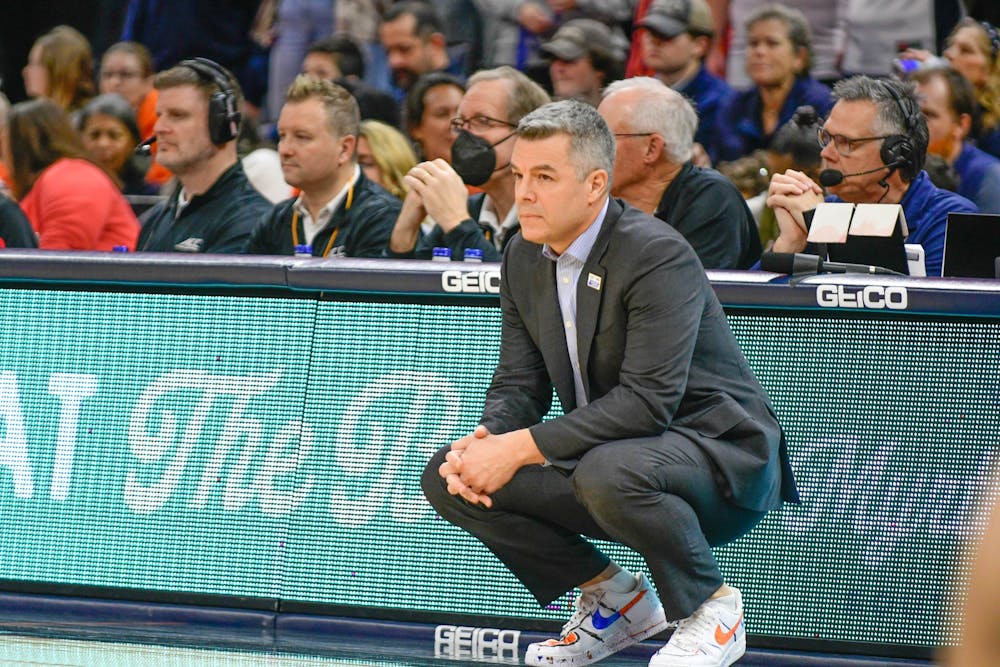Virginia basketball is in the midst of a dramatic resurgence. The Cavaliers (18-4, 10-3 ACC) are currently situated at No. 8 in the latest AP men’s basketball poll and have risen as high as No. 2 this season. Coach Tony Bennett’s squad has come a long way from last season’s disappointing end — a loss in the National Invitation Tournament after missing out on the NCAA Tournament for the first time in almost 10 years, excluding the pandemic-disrupted year.
Despite the success the Cavaliers have enjoyed this season, Bennett has shown that he is not afraid to shake up his lineup. Anyone who has watched Virginia’s last few games may have noticed his rotations shifting. The 6-foot-11 junior forward Kadin Shedrick has seen his minute share steadily decrease, culminating in a “did not play” in Saturday’s loss to Virginia Tech. Tuesday night, Shedrick returned to action off the bench, logging 27 highly impactful minutes en route to a home victory over No. 22 NC State.
Shedrick’s near-disappearance during a multi-game, in-conference stretch was surprising because many believed he was in line for a breakout season. He claimed the starting center role from senior Francisco Caffaro at the end of last season and did not look back. In addition, Shedrick’s offensive efficiency — like many of his teammates — improved, most notably through his 80.8 percent clip from the free throw line. When combined with his blocking ability, why did Shedrick find it so difficult to get in the game? To that point, should Virginia move forward with a reduced role for Shedrick or grant a bigger lineup more minutes as they have for most of the season?
The case for small ball
Clearly, “small” is used relatively here, since the player who benefited most from the lineup change — graduate transfer forward Ben Vander Plas – is 6-foot-8. Still, Bennett’s small ball lineup — consisting of graduate student guard Kihei Clark, graduate student forward Jayden Gardner, junior guard Reece Beekman, senior guard Armaan Franklin and Vander Plas — has no player taller than 6-foot-8 or that functions as a true center. This is an oddity for a Bennett-led team since his lineups have almost always featured a traditional big man — whether it be Jay Huff, Mamadi Diakite, Caffaro, or most recently, Shedrick. Vander Plas – who has often proved more comfortable shooting from the arc than backing someone down in the paint – is certainly not the prototypical Virginia big man.
Despite its abnormality, so far, Bennett’s small ball gamble has been moderately successful. In games that Shedrick logs fewer than 15 minutes, the Cavaliers have gone 5-2. One of the reasons Bennett has installed the small ball lineup could be to lean into the team’s newly-forged offensive identity. His Cavaliers have been shooting 38 percent from three — 23rd in the NCAA.
For proof that small ball can pay off, look no further than Virginia’s victory over Wake Forest. The Demon Deacons have two players in their starting five that are taller than Vander Plas. Despite their momentum and decent matchups against the Cavaliers, they ultimately fell in their first home loss against Bennett’s small ball lineup 76-67. Shedrick logged just three minutes.
Virginia shot 44.1 percent from beyond the arc, with Vander Plas knocking down two threes in the win. Despite the size disadvantage, the Cavaliers also secured 38 total rebounds to the Demon Deacons’ 32. For the most part, Vander Plas, Gardner and freshman guard Ryan Dunn have proven capable of matching up against larger players.
Presently, three-point shooting is one of the Cavaliers’ strengths, and Virginia is averaging its most points scored per game since the 2019 NCAA Championship team. Pulling Shedrick for Vander Plas adds yet another shooter to the floor that opposing teams have to account for behind the arc.
The case against small ball
Bennett’s investment in perimeter shooting had not resulted in significant rebounding or interior defense issues — at least until Saturday’s loss to the Hokies. In a game where Shedrick never touched the court, the Hokies torched Vander Plas and co. in the paint en route to a 74-68 victory. Though the Cavaliers defeated Virginia Tech just a few games prior with minimal involvement from Shedrick, the Hokies adjusted and never trailed in the rematch.
Crucial conference losses like Saturday’s and an earlier loss to Miami where Bennett played Shedrick for just 11 minutes are largely the reason that Virginia shares the top spot in the ACC rather than owning it outright.
The clearest argument in favor of Shedrick remaining in the rotation is Tuesday night’s victory over No. 22 NC State. The Wolfpack challenged Virginia with graduate forward D.J. Burns Jr., a 6-foot-9, 275-pound problem for Vander Plas and Gardner.
Though Bennett stayed with his new lineup at tipoff, Shedrick checked in early and defended Burns Jr. exceptionally, limiting NC State’s offensive potential as they scored just 50 points— well below its 78.4 average. Shedrick added 10 points, 12 rebounds and a block in a statement victory.
Down the line, Shedrick will likely have his number called again in key conference matchups. Duke (17-7, 8-5 ACC) has three starters that are 6-foot-8 or taller.
Conclusion
Bennett will have a decision to make when it comes time to face teams like Duke and the North Carolina Tar Heels (15-9, 6-3 ACC) that both have dangerous big men that function as the focal points of their offenses. His decision to prioritize perimeter shooting or interior defense could make or break a highly competitive Virginia team’s season.







